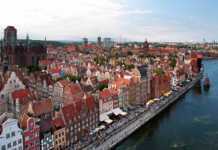Vietnam is a beautiful country with a fascinating history, beaches, mountains and vibrant cities. Of all the places I’d choose to go back to in Vietnam, Hoi An would be right at the top of my list. Why? Not only are there many intriguing things to do in Hoi An, but there are also fabulous beaches and an atmospheric old town.
Hoi An is located in the province of Quang Nam on the south-central coast of Vietnam. A vibrant Southeast Asian trading port from the 15th to 19th centuries, one of the best reasons to visit Hoi An is to soak up the historic ambience and explore it’s a UNESCO World Heritage architecture and many of Vietnam’s best landmarks. Hoi An’s culture is a blend of Chinese, Japanese, Dutch and Indian brought to the region by traders and sailors who settled in the area as far back as the 16th century.
Contents
- Hoi An
- Things To Do In Hoi An
- 1- Spend Time On The Beach
- 2- Tour Hoi An’s Old Town
- 3- Visit Fu Jian Temple
- 4- Order a Tailormade Suit
- 5- Take a cyclo ride around Hoi An
- 6- Try local Hoi An Food
- 7- Visit Hoi An’s Markets
- 8- Take a cooking class
- 9- Explore World Heritage My Son
- 10- Cruise The River
- 11- Snorkel The Cham Islands
- 11- Visit Ba Na Hills
- 12- Visit A Fishing Village or Farm
- 13- Take A Tour of Marble Mountain
- 14- Ride A Scooter Around The Countryside
- 15- Go Biking And Kayaking
- 16- Immerse Yourself in the Lantern Festival
- 17- Explore Hoi An’s Fishing Heritage
- 18- Enjoy Vietnamese Coffee
- 19- Discover the Charm of Thanh Ha Village
- 20- Attend a Lantern-Making Workshop
- 21- Discover Traditional Handicrafts at Kim Bong Carpentry Village
- 22- Admire the Art at Lifestart Foundation Workshop
- 23- Explore the Tra Que Vegetable Village
- 24- Pamper Yourself at a Spa
- 25- Participate in a Rice Farming Tour
- 26- Cruise Through the Coconut Forest
- Things To Do In Hoi An
Hoi An
Things To Do In Hoi An
1- Spend Time On The Beach
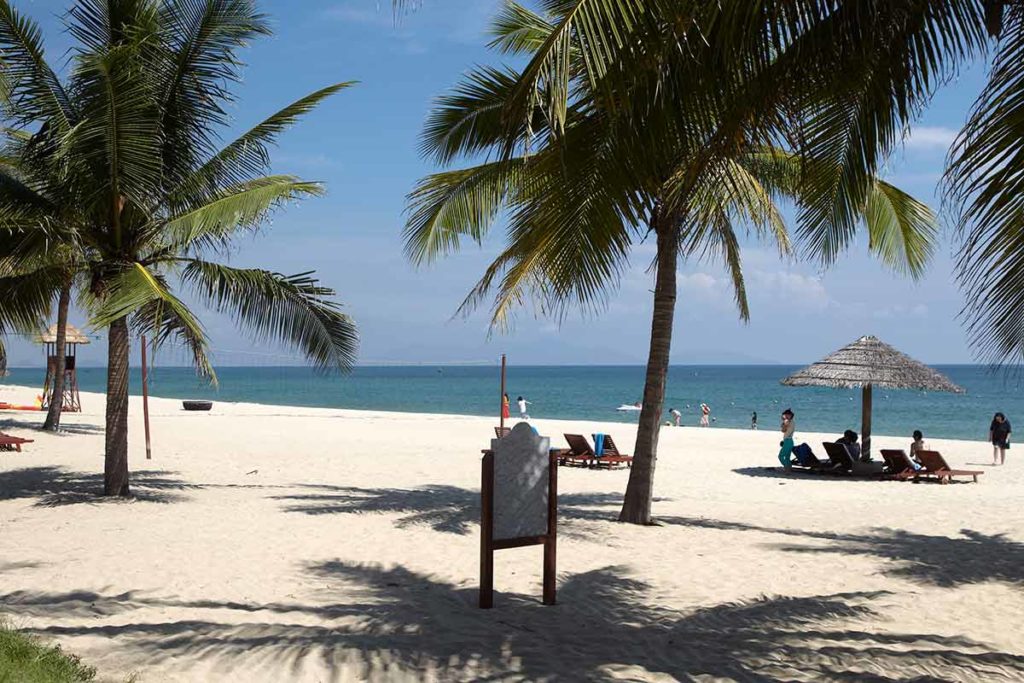
As Hoi An is on the east coast, going to the beach is a great way to watch the sunrise.
Hoi An’s beaches are great spots to escape the humidity and enjoy a breeze.
The most famous beach in the area is China Beach, for its starring role in the movie Apocalypse Now, where American ground combat units waded ashore to establish a base in Vietnam.
Cua Dai Beach is a quieter beach, with an alluring stretch of white sand and a locally-owned four-star hotel Palm Gardens Resort has direct access to the beach.
The resort’s garden has a great setup, with timber deck chairs, thatch parasols, shady palms and hammocks.
An Bang Beach is at the end of the main road leading out of Hoi An and has access to bars, restaurants, watersports and beach lounges for hire.
Not far from An Bang Beach is An Bang South and there’s Hidden Beach, where you can order a seafood meal on the beach at Hidden Beach restaurant.
Check the latest prices of hotels in Hoi An here
2- Tour Hoi An’s Old Town
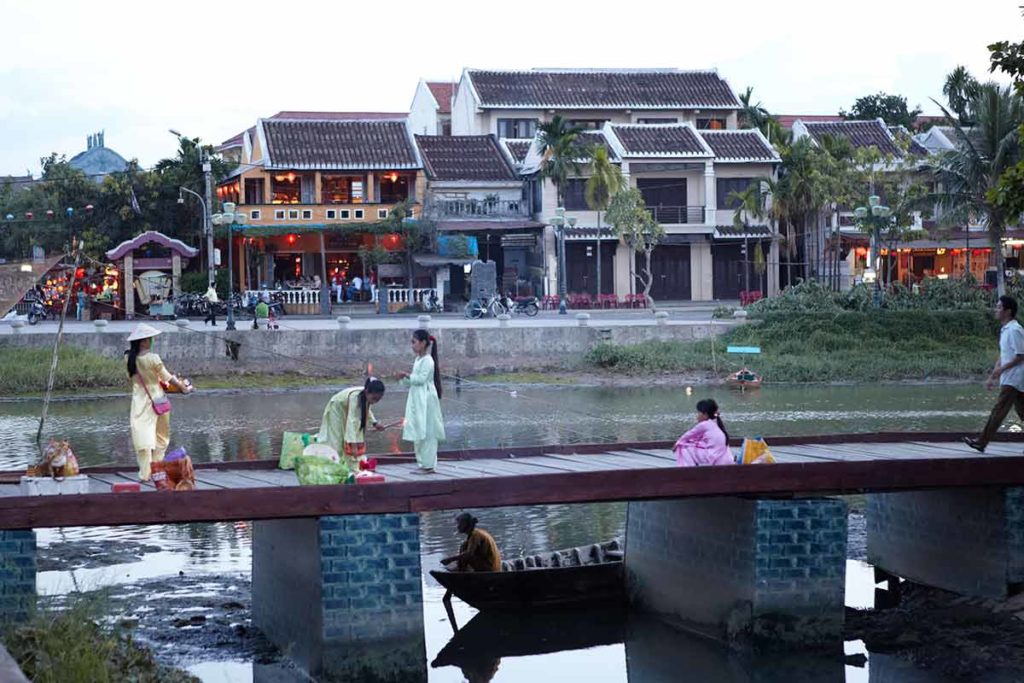
As you wander around UNESCO World Heritage the historic quarter, admiring the Vietnamese, Japanese and Chinese houses, you can picture the bustling trading port if must have once been.
Back in the 16th and 17th centuries, Hoi An was a busy spice trading centre.
The historic merchants’ houses have been converted into galleries, antique stores, restaurants and bars.
Explore Chinese assembly halls and take a photo at the Japanese Bridge, which is a recognisable landmark of Hoi An.
After 10 am, Hoi An’s Old Town is a pedestrian zone.
A 120,000 dong ($6) pass from the Hoi An Office of Tourist Services offers entry to 22 historic temples, museums and assembly halls or if you prefer to delve deeper into history book a walking tour of Hoi An’s Old Town.
While in the Old Town, take a look at these attractions:
The Japanese Covered Bridge
This iconic symbol of Hoi An, dating back to the 18th century, is a beautiful piece of Japanese architecture. Don’t forget to snap some photos.
The Japanese Covered Bridge, known locally as Chùa Cầu, was constructed in the early 18th century by the Japanese trading community in Hoi An.
This historic structure was built to connect the Japanese quarter of the town with the Chinese quarters, symbolizing peace and unity between the two cultures.
The bridge’s roof was added to provide shelter from the weather, making it not only a functional piece of architecture but also a place of spiritual significance.
Over the centuries, the bridge has undergone several restorations, but it still retains its original charm and continues to be a testament to Hoi An’s rich cultural tapestry.
The Old House of Tan Ky
Step back in time with a visit to the Old House of Tan Ky, a 200-year-old merchant’s home showcasing Chinese and Japanese architectural influences.
This well-preserved house is a great example of the fusion of cultures in Hoi An and offers a glimpse into the daily life of prosperous merchants during the 18th century.
Wander through its intricately carved wooden doors, admire the ancient family altar, and marvel at the ornate details throughout the house.
Hoi An Museum
Get a deeper understanding of Hoi An’s rich history by exploring the exhibits at the Hoi An Museum, which showcases a diverse collection of artifacts that span the region’s history, from ancient relics unearthed from archaeological sites to traditional costumes and everyday items used by the local people.
One of the highlights is the display on Hoi An’s time as a bustling trading port, featuring historical documents, maps, and trade goods that illustrate its prominence in maritime commerce.
Additionally, the museum features an array of splendid ceramics and pottery, reflecting the skill and artistry of local craftsmen through the ages.
Visitors can also find detailed exhibits on the fusion of cultures that have shaped Hoi An, including Vietnamese, Chinese, and Japanese influences.
The Hoi An Museum provides a comprehensive and engaging narrative, offering visitors a vivid illustration of the town’s vibrant and multifaceted heritage.
3- Visit Fu Jian Temple
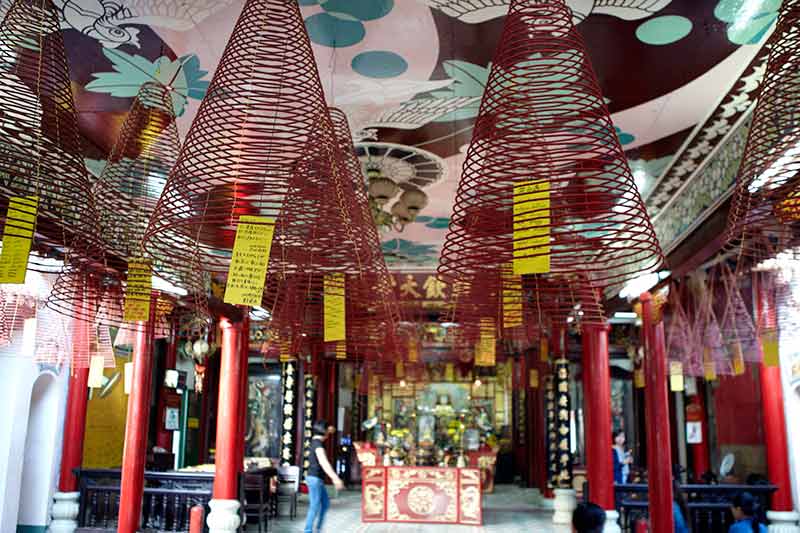
Fu Jian temple was built in 1967 by the Chinese who came to Hoi An from China to escape the tyranny of the Ming Emperors.
The Ming Dynasty’s long arm reached Vietnam and other parts of Southeast Asia, shaping the lives and direction of the local people.
Initially, the temple was used as an assembly hall by the clan.
Later, it was turned into a temple dedicated to Lady Jing Hao who was believed to have the power of rescuing fishermen from calamities at sea. Even today, Vietnamese sailors and their descendants continue to worship the Lady of the Sea.
The temple has Chinese lion statues and shrines.
4- Order a Tailormade Suit

With over 400 tailor shops and rows of shoemakers, even if you don’t have any intention of going shopping, it’ll be hard to resist.
The Old Town is a shopping nirvana packed with galleries, souvenir, craft, clothing and shoe shops.
You can have shoes and clothes custom made for a lot less than it would cost to buy off the rack at home.
Tran Hung Dao Street is packed with tailors and shoemakers who work quickly and can sew an entire wardrobe in less than 24 hours.
Expect to pay around USD$150 for a suit and about USD$90 for a dress.
How to select a tailor
- It’s a good idea to bring a favourite suit or dress for the tailor to copy.
- Make sure you negotiate as the initial price is likely to be much higher than you need to pay.
- Shop around and compare prices and quality before deciding.
5- Take a cyclo ride around Hoi An
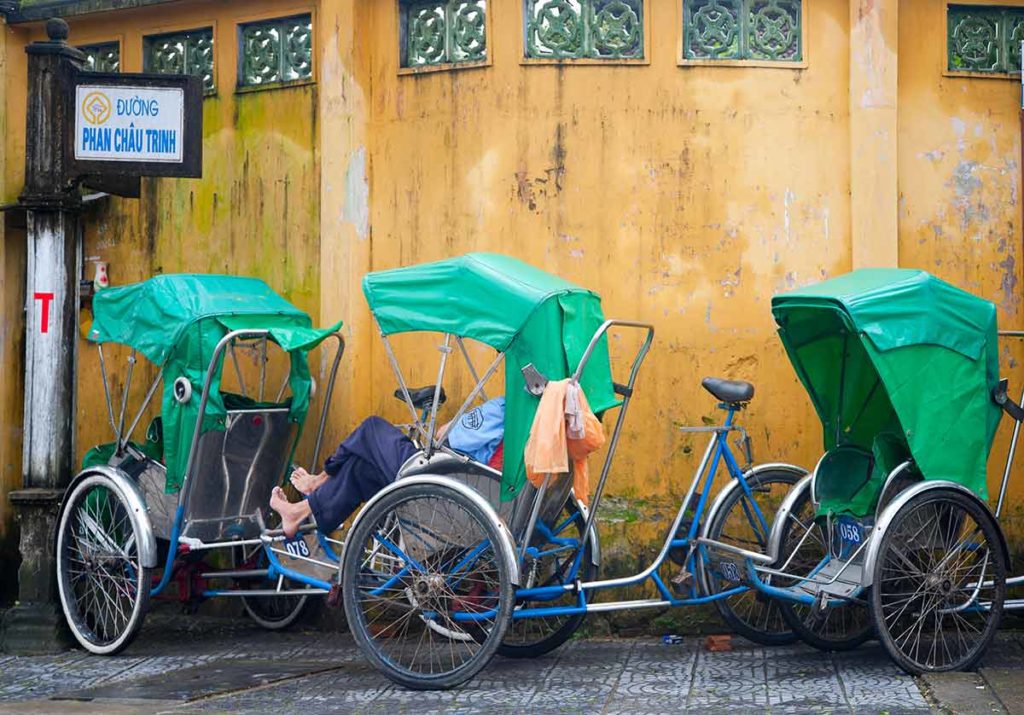
Get off your feet and into a cyclo (a three-wheeled bicycle pedalled by a hard-working cyclo driver).
It’s a relaxing way to get around, and you’ll be helping the economy and keeping a local in a job.
Make sure you don’t pay the cyclo driver the asking price as these fellas are known for overcharging.
Alternatively, you can hire a bicycle for around $2 a day.
6- Try local Hoi An Food
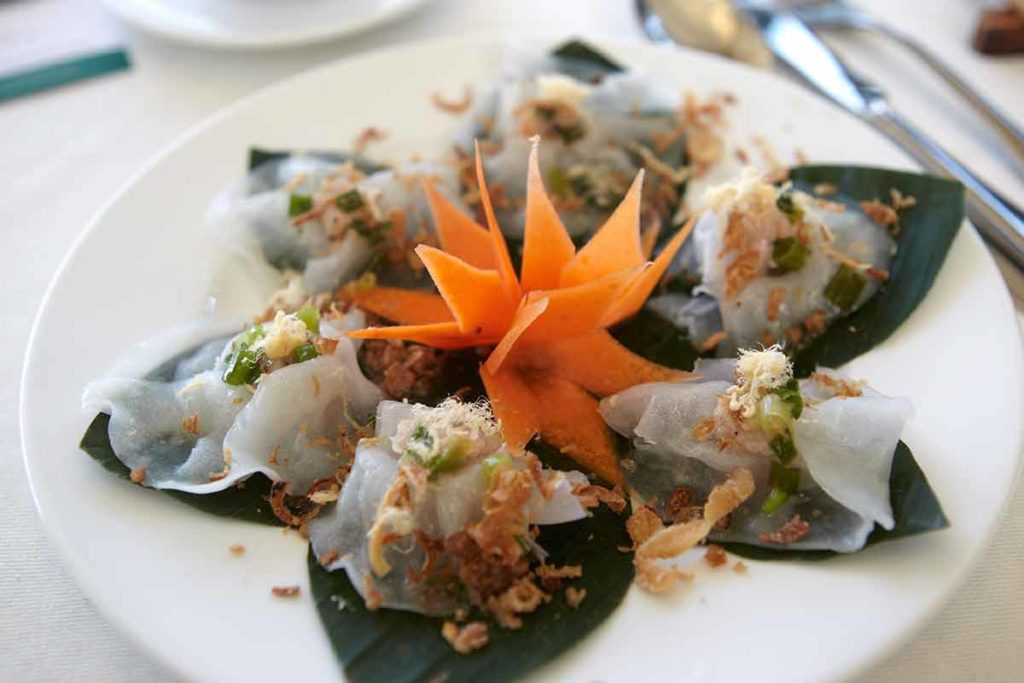
Local food in Hoi An is fresh, inexpensive and delicious.
Hoi An is famous for Cau Lau, which are special noodles made from water drawn from the Ba Le Well, Com Ga chicken rice, and white rose dumplings made at the White Rose restaurant (533 Hai Ba Trung) with a secret family recipe.
White Rose dumplings are prawn-filled dumplings arranged to resemble a rose, with fried onion topping and a dipping sauce.
A bottle of beer costs between $1 and $2 in a local restaurant, a bowl of pho around $1.50 and a massage in a local parlour between $5 and $10.
7- Visit Hoi An’s Markets
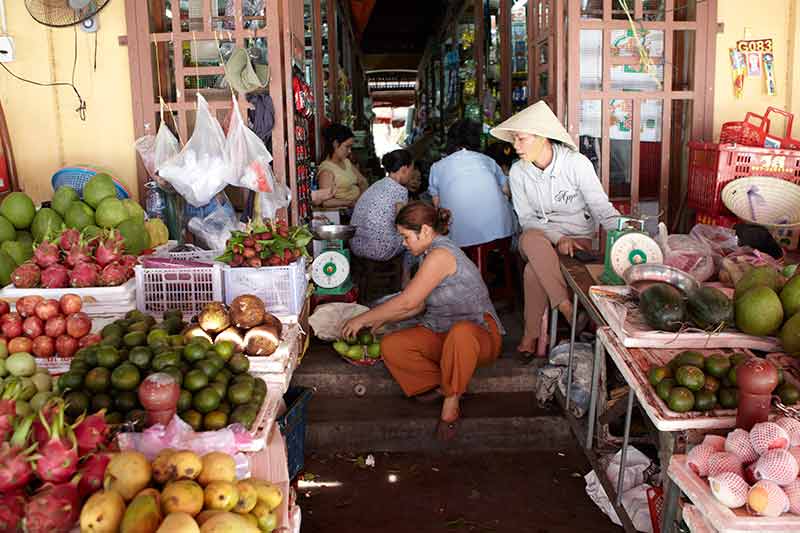
The produce market in Hoi An is a hub of activity but make sure to visit first thing in the morning for the freshest produce.
Keep your eye out for Vietnamese spices, Bot Ngu Vi Huong (five aroma powder), which is sold in sealed packets, as it’s a perfect gift.
You can combine a shopping tour of a local produce market with a cooking class.
Another market to visit is the Hoi An fish market by boat to watch the locals haggle over fresh fish.
8- Take a cooking class
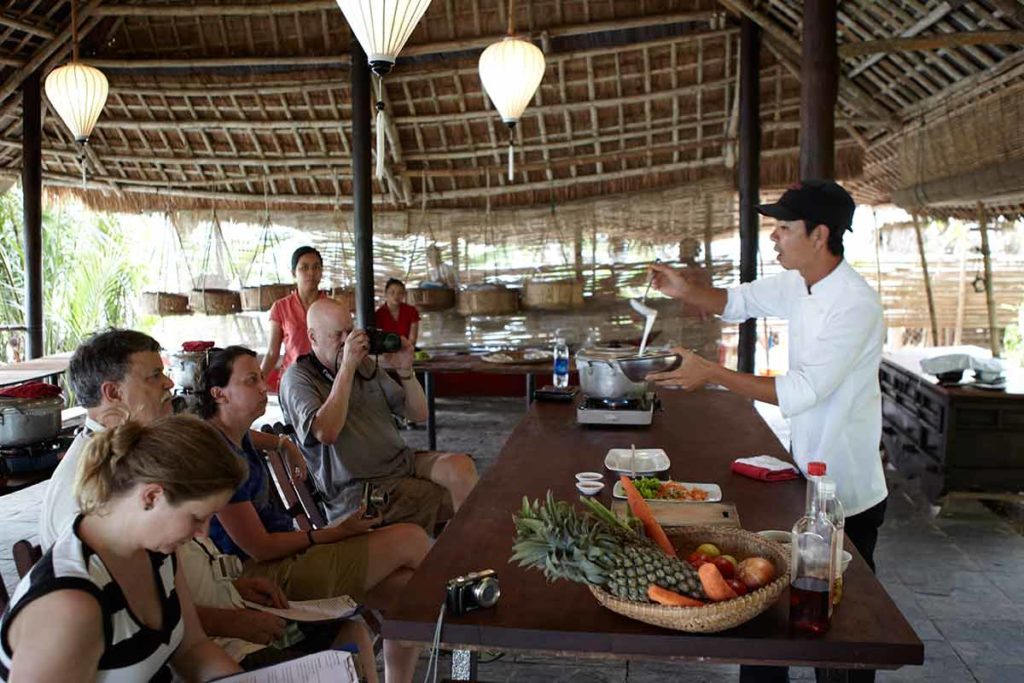
You can learn to cook Vietnamese food anywhere in the world, but there’s nothing more memorable than attending a cooking class in Vietnam.
It’s a fun and inexpensive way to learn new recipes, and it can be very entertaining.
In Hoi An, there are plenty of schools to choose from, including Morning Glory and the Red Bridge Cooking School, which is a short boat trip from the centre.
Red Bridge Restaurant and Cooking School
Red Bridge has day classes in the countryside and night classes in their cafe in the Old Town.
Learn how to make rice paper rolls during a half-day cooking school at Red Bridge and help the chef pick herbs in the school garden.
Green Bamboo Cooking School
Green Bamboo is a famous cooking school in the Old Town and joining a class is a social event.
Tip: Don’t express your appreciation of the food by saying it’s yummy. You might get more than you’ve bargained for as in the Vietnamese language, “yummy” means you’re feeling sexually aroused!
Check the latest prices of hotels in Hoi An here
9- Explore World Heritage My Son
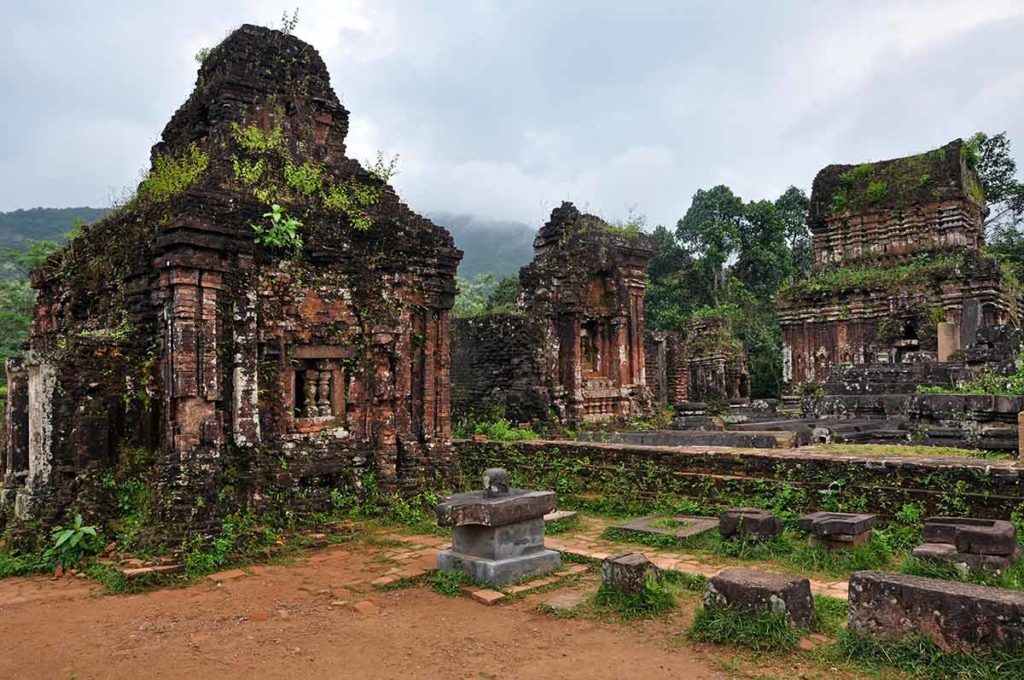
My Son is a UNESCO World Heritage Site about an hour and a half by road from Hoi An.
Once the capital of the Champa Kingdom, the crumbling remains of 4th to 13th-century Hindu temples sit in a lush valley with views of the surrounding mountains.
The Champa Kingdom was an ancient Indochinese kingdom that in central and southern Vietnam formed in 192AD when a Han Dynasty official from China decided to establish his kingdom.
French archeologist Henri Parmentier discovered the site in 1903.
Although the ruins are falling, there are stunning bas reliefs of snakes, elephants and war scenes.
10- Cruise The River
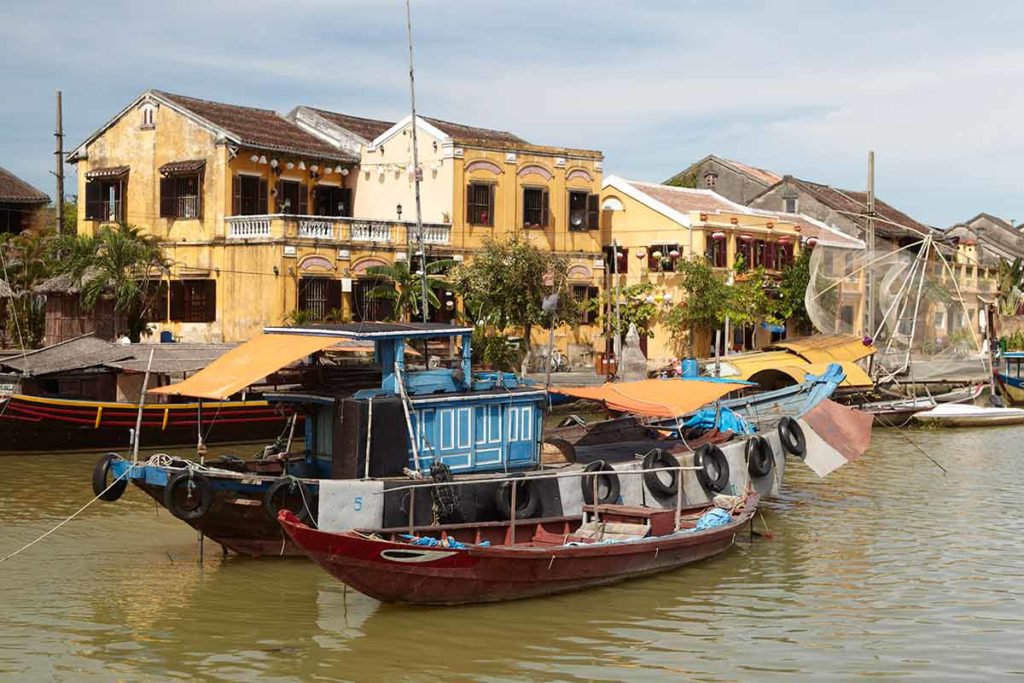
During the 7th to 10th centuries, Hoi An was a major port of the Cham Kingdom due to its location on the Hoai (or Thu Bon) River.
Today, the colourful waterscape of timber boats and shophouses is a scenic backdrop for a river cruise.
Sipping cocktails as your cruise the river is a relaxing way to end the day then enjoy a romantic dinner while floating around on the water.
A trip in a local boat costs around $3 an hour, and you can book a cocktail and dinner cruise here.
11- Snorkel The Cham Islands
20km to Hoi An’s east, the waters around the eight Cham Islands offer swimming, snorkelling and scuba diving.
The islands have lovely beaches and lush hills covered in forest.
There are fishing villages on one island and diving sites with coral gardens, underwater pinnacles and rock formations.
11- Visit Ba Na Hills
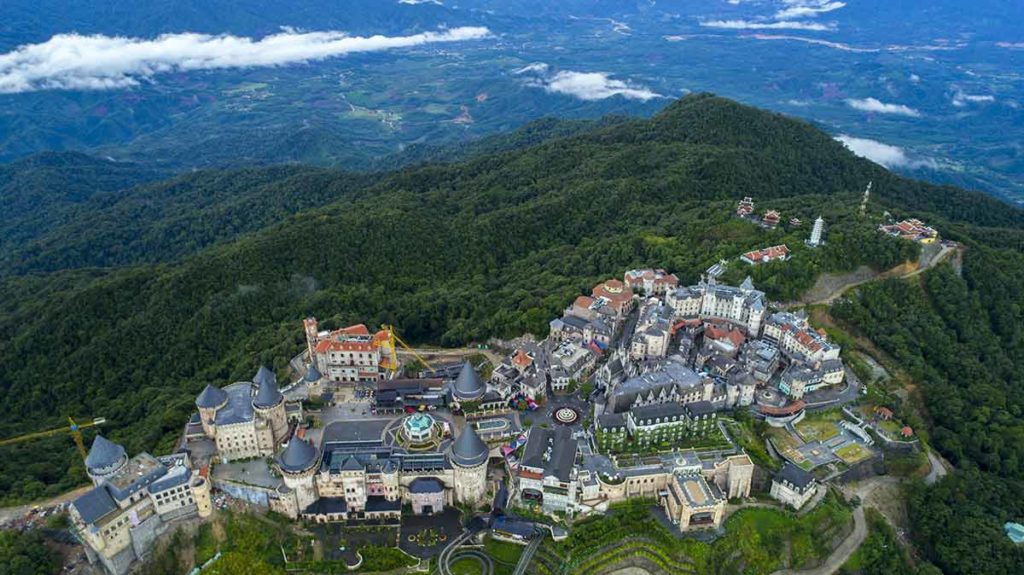
Ba Na Hills is an entertainment complex built and a refreshing mountain escape at 1,500 m (4,921 feet).
It is built to look like a Medieval castle, with a fantasy park with rides, the world’s longest cable car (with views of Danang) and a charming imitation French village with cobblestone streets.
Drink wine at the Debay wine cellar, take a photo at Linh Ung pagoda’s giant Buddha and stroll around the Loc Uyen garden.
Wander around the Ba Na Hills Wax Museum or get your thrills on one of the amusement park rides.
12- Visit A Fishing Village or Farm

Visiting a rice farm complete with water buffalo or a fishing village by boat are great ways to delve into Hoi An’s culture.
Buffaloes are prized by Vietnamese farmers and used to plough the land with their large hooves and strong bodies.
Rice farming has been done this way for centuries and scenes of women picking rice with water buffaloes in the background are classic.
13- Take A Tour of Marble Mountain
Marble Mountain’s caves and grottos are intriguing to explore, and the view from the mountain top is stunning.
The five marble and limestone hills are named for the five elements Kim, Thuy, Moc, Hoa and Tho.
Stone steps lead up to a Buddhist pagoda, and there’s a quaint stone village at the foot of the mountain, where you can watch local sculptors create marble products.
Marble Mountain is at Ngũ Hành Sơn District, which is to the south of Da Nang.
14- Ride A Scooter Around The Countryside
One of the best ways to soak up local life is to hire a scooter and explore the countryside around Hoi An.
A guided tour offers the opportunity to visit local homes, meet local families and experience their way of life.
Ride across bridges, past rice fields and into markets.
Riding a scooter is not that difficult but if you’re unsure about scootering around, another option is to book a motorbike sidecar.
15- Go Biking And Kayaking
Active travellers who love biking and kayaking might want to try exploring the countryside on two wheels and along the river.
Not far from Hoi An’s old town is the rural Hoi region, where you can visit local workshops to see the artisans at work.
Paddling back along the river to Hoi An is a great way to see another side of this UNESCO World Heritage city.
16- Immerse Yourself in the Lantern Festival
If you’re visiting during a full moon, don’t miss the Lantern Festival, when the town transforms into a magical wonderland with colourful lanterns lighting up the streets and waterways.
During the Lantern Festival, locals and visitors gather to release paper lanterns onto the Thu Bon River, creating a mesmerizing spectacle of floating lights.
The festival is not only visually stunning but also rich in tradition and meaning.
Each lantern carries the hope of the person who sets it afloat, symbolizing wishes for health, happiness, and prosperity.
As you wander through the illuminated streets, you’ll encounter traditional music and dance performances, adding a lively and cultural dimension to the festival.
Vendors line the streets, offering an array of street food and handcrafted souvenirs, making it a delightful experience for all your senses.
This enchanting event provides a perfect opportunity to soak in the unique cultural atmosphere of Hoi An and create unforgettable memories under the glow of thousands of lanterns.
17- Explore Hoi An’s Fishing Heritage
Hoi An’s fishing heritage is deeply intertwined with its history and culture, dating back centuries to when the town thrived as a busy trading port.
The waterways around Hoi An, including the Thu Bon River and the South China Sea, have long provided abundant marine resources, sustaining the local community through fishing and related maritime industries.
Traditional fishing practices have been passed down through generations, making fishing not just an occupation but also a way of life for many residents.
You’ll find iconic round basket boats, known as “thung chai,” dotting the waters of Hoi An, used by fishermen for their stability and maneuverability.
These boats are an essential part of the local fishing tradition, often used in tandem with unique fishing nets and techniques that have been honed over the years.
Joining a fishing tour offers a firsthand experience of these practices, allowing visitors to participate in net casting and crab catching, guided by knowledgeable local fishermen.
In the early morning, the markets in Hoi An buzz with activity as fishermen bring in their fresh catch of the day, including fish, prawns, crabs, and a variety of shellfish.
Visiting one of these bustling markets is the perfect way to see the direct link between the fishing industry and the town’s culinary scene.
The vibrant seafood dishes you’ll find in local restaurants are a testament to Hoi An’s rich fishing heritage, featuring ingredients that are fresh, sustainable, and deeply flavoursome.
18- Enjoy Vietnamese Coffee
Stop by a local café and enjoy a cup of strong Vietnamese coffee. Make sure to try it with condensed milk for a sweet treat.
Making Vietnamese coffee is a delightful process that combines richly brewed coffee with the sweet creaminess of condensed milk, resulting in a beverage that is both invigorating and indulgent.
If you’d like to get into the mood, here’s a simple guide to help you create this iconic drink at home:
Vietnamese Coffee Recipe
Ingredients:
2 tablespoons of Vietnamese ground coffee (Cà phê)
2 tablespoons of sweetened condensed milk
Hot water
Ice (optional, for iced Vietnamese coffee)
Equipment:
A Vietnamese drip filter (Phin) or a French press
A glass or mug
Instructions:
- Prepare the Filter: Start by placing the Vietnamese drip filter on top of your glass or mug. Add 2 tablespoons of ground coffee to the filter. Give the filter a gentle shake to spread the coffee grounds evenly.
- Add Condensed Milk: Pour 2 tablespoons of sweetened condensed milk into the bottom of the glass or mug. This will serve as the sweet base for your coffee.
- Bloom the Coffee: Pour a small amount of hot water (around 200°F or 93°C) over the coffee grounds in the filter. Wait for about 30 seconds to let the coffee “bloom” — this releases the carbon dioxide and enhances the flavor profile.
- Brew the Coffee: Slowly add the remaining hot water to the filter, filling it to the top. Place the lid on the filter and allow the coffee to drip through over the next 4-5 minutes. Be patient; the slow drip is essential for strong, full-bodied coffee.
- Mix and Enjoy: Once the coffee has finished dripping, remove the filter. Stir the coffee and condensed milk together until fully combined. For an iced version, pour the mixture over a glass filled with ice and stir again.
Now, sit back and savour your homemade Vietnamese coffee, a perfect blend of robust coffee and sweet creaminess that provides a delightful pick-me-up any time of day.
19- Discover the Charm of Thanh Ha Village
Thanh Ha Village, located just a few kilometers west of Hoi An, is a quaint village known for its rich history in traditional pottery making.
For centuries, the artisans of Thanh Ha have crafted beautiful and functional ceramics, using techniques passed down from generation to generation.
Visiting Thanh Ha Village offers a glimpse into this enduring craft, with the opportunity to see firsthand the meticulous processes involved in creating pottery.
The village itself is a picturesque setting, with a serene riverside ambiance and narrow lanes lined with pottery workshops.
As you stroll through Thanh Ha, you’ll observe skilled potters at their wheels, shaping clay into everything from intricate vases and teapots to everyday household items.
One highlight of visiting Thanh Ha Village is participating in a pottery-making class, where, under the guidance of experienced potters, you can try your hand at molding and shaping your own ceramic piece.
20- Attend a Lantern-Making Workshop
Lanterns are an integral part of Hoi An’s cultural identity and aesthetic charm.
These radiant, hand-crafted lanterns gleam brightly across the ancient town, bringing a magical ambiance that enchants both locals and visitors alike.
Hoi An’s lantern-making tradition dates back to its days as a prominent trading port, where influence from Chinese and Japanese cultures introduced this luminous art form.
The town celebrates this heritage during the Lantern Festival, held on every 14th day of the lunar month, where electric lights are turned off, and the streets glow solely by the light of colorful lanterns.
Crafting these lanterns is a meticulous process involving several steps, each requiring precision and care.
Artisans start with a bamboo frame, which is then meticulously covered using silk or other vibrant fabrics.
Each lantern is unique, often adorned with intricate patterns and symbols representing good fortune, happiness, and prosperity.
Visitors to Hoi An can take part in lantern-making workshops, offering a hands-on experience in this traditional craft.
These workshops not only allow participants to create their own beautiful lanterns but also provide deeper insight into the cultural significance and craftsmanship that goes into each piece.
21- Discover Traditional Handicrafts at Kim Bong Carpentry Village
Located on the Cam Kim Island, just a short boat ride from Hoi An, Kim Bong Carpentry Village boasts a rich history that dates back to the 15th century.
This village has long been renowned for its exceptional woodwork, from intricately carved furniture to detailed architectural elements that grace many historical structures in the region.
The artisans of Kim Bong have mastered various woodworking techniques, allowing them to create a wide range of products, from everyday household items to elaborate sculptures and traditional boats.
Visitors to Kim Bong Carpentry Village can explore numerous workshops where skilled carpenters work diligently at their craft.
The atmosphere is vibrant with the rhythmic sounds of chisels and saws, and the air is rich with the scent of freshly cut wood.
Guided tours offer an in-depth look at the entire carpentry process, from selecting the right type of wood to the final polishing touches that bring each piece to life.
Engaging with the local craftsmen, visitors gain insight into the dedication and artistic vision required to maintain this traditional craft.
Many workshops also offer demonstrations and hands-on activities, providing a unique opportunity to try sculpting or carving under the expert guidance of the village’s artisans.
These experiences not only foster a deeper appreciation for the craft but also help preserve the village’s cultural heritage for future generations.
22- Admire the Art at Lifestart Foundation Workshop
Support local artists and admire their work at the Lifestart Foundation Workshop, which helps disadvantaged locals find employment through art.
The Lifestart Foundation Workshop is more than just a place to admire art; it is a hub of social enterprise focused on creating sustainable livelihoods for disadvantaged individuals in the community.
By offering employment opportunities to those in need, the foundation helps foster self-sufficiency and economic independence.
The workshop supports a range of artistic disciplines, from traditional crafts to contemporary art, allowing local artists to express their creativity while earning a stable income.
Visitors to the Lifestart Foundation Workshop can participate in unique, hands-on experiences such as painting, lantern-making, and other traditional Vietnamese crafts.
These activities not only provide visitors with an enjoyable and educational experience but also directly support the artisans by giving them meaningful work and a chance to share their skills with a wider audience.
The foundation operates under a fair trade model, ensuring that the artists receive fair compensation for their efforts.
23- Explore the Tra Que Vegetable Village
Visit the Tra Que Vegetable Village to learn about traditional farming methods and even participate in the gardening process.
Named after a sweet-scented herb that is exclusively found in this area, Tra Que Vegetable Village offers a unique glimpse into traditional Vietnamese farming practices.
Located just a few kilometers from Hoi An, this charming village is celebrated for its lush, organic vegetable gardens that produce a wide variety of herbs and greens used in Vietnamese cuisine.
The fertile soil, enriched by the local river and seaweed compost, lends extraordinary flavor and freshness to the vegetables grown here.
Visitors to Tra Que can enjoy an immersive experience that goes beyond mere observation.
Engaging in the daily activities of the village, they can try their hand at preparing the soil, planting seeds, and harvesting crops alongside local farmers.
These hands-on activities offer a profound appreciation for the labor-intensive techniques that have sustained this community for generations.
The village provides comprehensive guided tours that highlight the significance of each herb and vegetable, elucidating their roles in traditional dishes and local health remedies.
After working in the fields, guests are often treated to a cooking class where they can use freshly picked ingredients to prepare authentic Vietnamese meals.
Tra Que Vegetable Village not only showcases sustainable agriculture but also emphasises the importance of preserving cultural practices.
By participating in the life of the village, visitors support the local economy and help maintain a way of life that celebrates harmony with nature.
24- Pamper Yourself at a Spa
Indulge in the ultimate relaxation experience by visiting some of Hoi An’s renowned spas, where traditional techniques and modern luxuries blend seamlessly to rejuvenate your mind, body, and spirit.
Ylang Ylang Spa: Located in the heart of the ancient town, Ylang Ylang Spa offers a serene escape with a variety of treatments that incorporate local herbs and essential oils. Signature treatments include the Vietnamese herbal massage, which uses a combination of heated herbal compresses and deep tissue techniques to relieve muscle tension and enhance circulation.
La Spa: La Spa provides a holistic approach to wellbeing, offering therapeutic treatments designed to balance and restore. One of their popular services is the ‘La Wellness Journey’, a comprehensive package that includes a body scrub with locally sourced coffee, a detoxifying body wrap, and a soothing aromatic massage to leave you feeling refreshed and invigorated.
White Rose Spa: Named after the famous Hoi An dish, White Rose Spa delivers a truly local experience. The spa focuses on traditional Vietnamese therapies such as ‘cupping’ and ‘gua sha’, which are believed to improve energy flow and promote healing. Another must-try is their unique rice bran body scrub, renowned for its exfoliating and skin-softening properties.
Botanica Spa: Nestled amidst lush greenery, Botanica Spa offers a peaceful retreat with a focus on natural wellness. Their signature treatments include the ‘Four Hand Massage’, where two therapists work in unison to provide a deeply relaxing experience, and the ‘Herbal Detox Foot Bath’ which uses native herbs to relieve stress and detoxify the body.
Palmarosa Spa: Palmarosa Spa is revered for its wide array of facial treatments that incorporate organic ingredients. Their ‘Royal Vietnamese Facial’ uses fresh herbs and rice bran to cleanse, exfoliate, and hydrate your skin, leaving it glowing and revitalized. They also offer a range of hot stone and aromatherapy massages tailored to each guest’s needs.
By luxuriating in these rejuvenating treatments, visitors not only unwind but also gain an appreciation for the rich heritage of Vietnamese wellness practices.
25- Participate in a Rice Farming Tour
Experience the life of a rice farmer by joining a hands-on rice farming tour. You’ll learn how to plant, harvest, and process rice.
Through this immersive tour, visitors gain invaluable insights into the intricate and labour-intensive process of rice cultivation.
Guests are then outfitted with traditional farming attire, including conical hats and water buffalo-driven plows.
The tour guides participants through various stages of rice production.
You’ll start by preparing and plowing the fields, an activity that offers a genuine feel for the physical demands faced by rice farmers.
Next, you’ll have the opportunity to plant young rice seedlings in the flooded paddies, a method that requires meticulous attention to ensure each seedling is properly spaced.
Harvesting is another highlight, where you can try your hand at cutting rice stalks using age-old techniques.
The tour concludes with a demonstration of the rice threshing process, which separates the grains from the stalks.
Throughout the experience, participants are encouraged to ask questions and engage with the farmers, gaining a profound appreciation for the dedication and skill involved in this essential agricultural practice.
Overall, the rice farming tour offers a unique blend of education, cultural immersion, and interactive fun, creating lasting memories and a deeper understanding of rural life in Vietnam.
26- Cruise Through the Coconut Forest
Take a basket boat tour through the serene coconut forest in Cam Thanh Village. It’s a unique and tranquil experience you won’t forget.
Winding through the lush mangroves of the Cam Thanh coconut forest, the basket boat tour offers an enchanting exploration of one of Hoi An’s most captivating natural landscapes.
Known for its vast groves of water coconut palms, the forest is an ecological treasure trove that provides shelter to a diverse array of wildlife, including various fish species, birds, and crustaceans.
As you glide through the serene waterways in the traditional circular bamboo boats, expertly navigated by skilled local oarsmen, you’ll have the chance to witness impressive fishing demonstrations and learn the traditional techniques used by local fishermen for generations.
The tour often includes interactive activities such as fishing for crabs using simple bait and line methods and crafting intricate palm leaf creations, providing a hands-on experience of the local culture.
The journey through the coconut forest is not just a visual feast of greenery and tranquil waters, but also an auditory immersion where the sounds of nature – rustling palm fronds, bird calls, and the gentle splash of oars – create a symphony of relaxation.
This tranquil adventure offers a deeper connection to the environment and a profound appreciation for the sustainable practices that have preserved this natural haven for future generations.
For more things to do in Vietnam, read:
- 20 Things To Do In Ho Chi Minh City
- 15 Things To Do In Hanoi
- 15 Things To Do In Hoi An
- 20 Things To Do In Hue
- Vung Tau Travel Guide
- Vietnam River Cruise
- Hanoi vs Ho Chi Minh City
- 20 Beaches In Vietnam
- 20 Vietnam Cities
- Where To Stay In Hanoi
- Where To Stay In Ho Chi Minh City
- Where To Stay In Hoi An
- 20 Things To Do In Phu Quoc
- 20 Things To Do In Nha Trang
- 20 Islands In Vietnam
- 20 Things To Do In Danang
- 20 Things To Do In Dalat
- 20 Things To Do In Sapa
- Everything You Need To Know About Living In Vietnam
- 15 Things Vietnam Is Famous For
- 20 Beachfront Villas and Overwater Bungalows in Vietnam
Plan Your Trip

Rent A Car – Find the best car rental rates at Discover Cars. They compare car hire companies to provide you with the best deal right now.

Find A Hotel – If you’re curious about this article and are looking for somewhere to stay, take a look at these amazing hotels.


